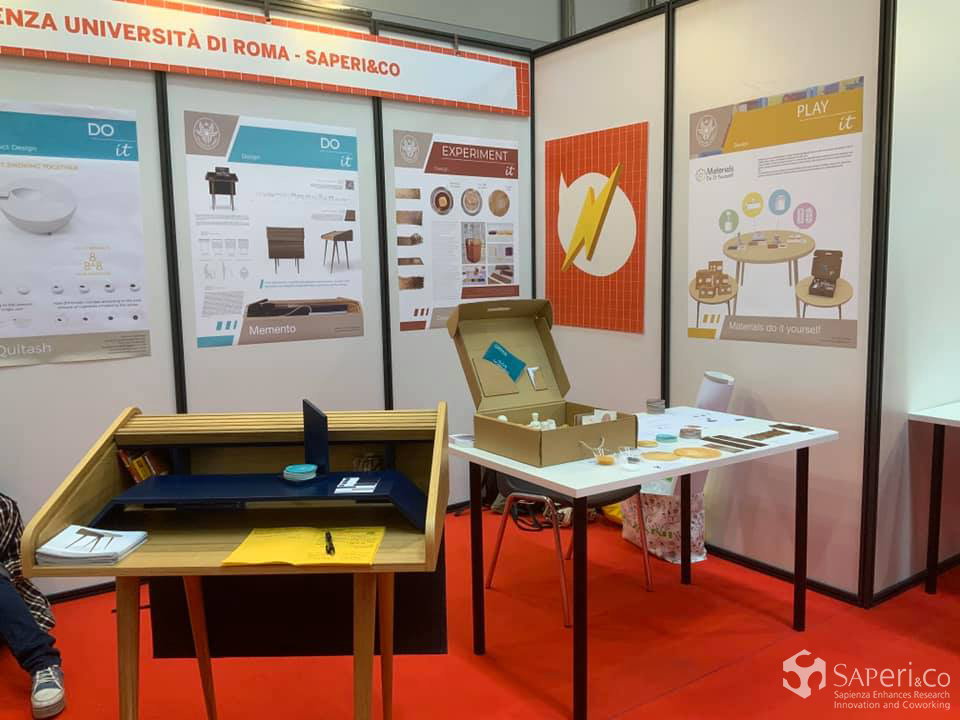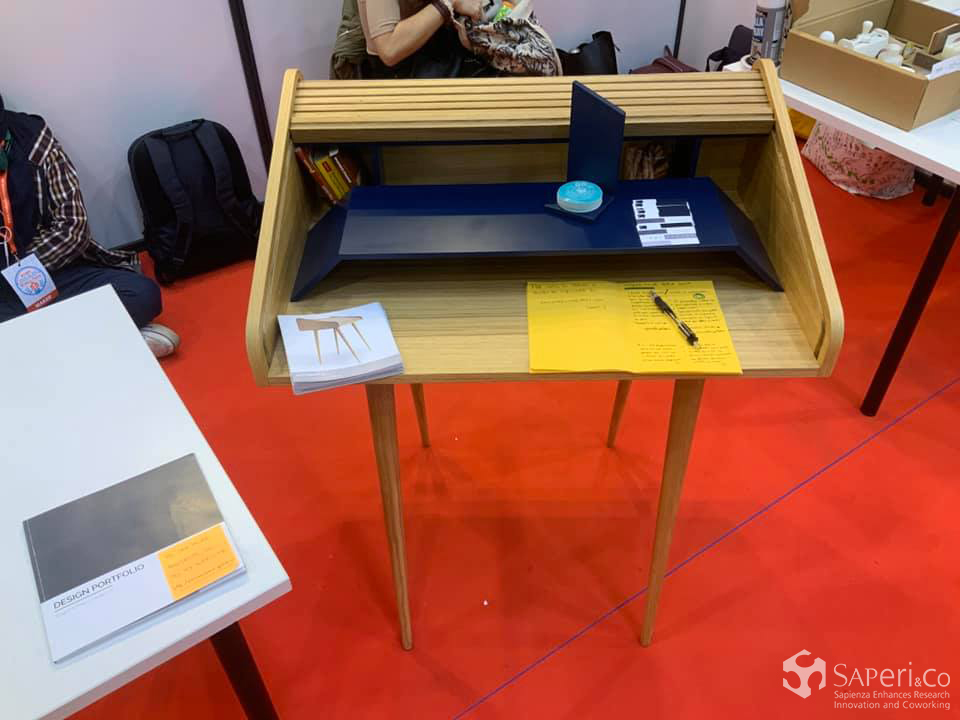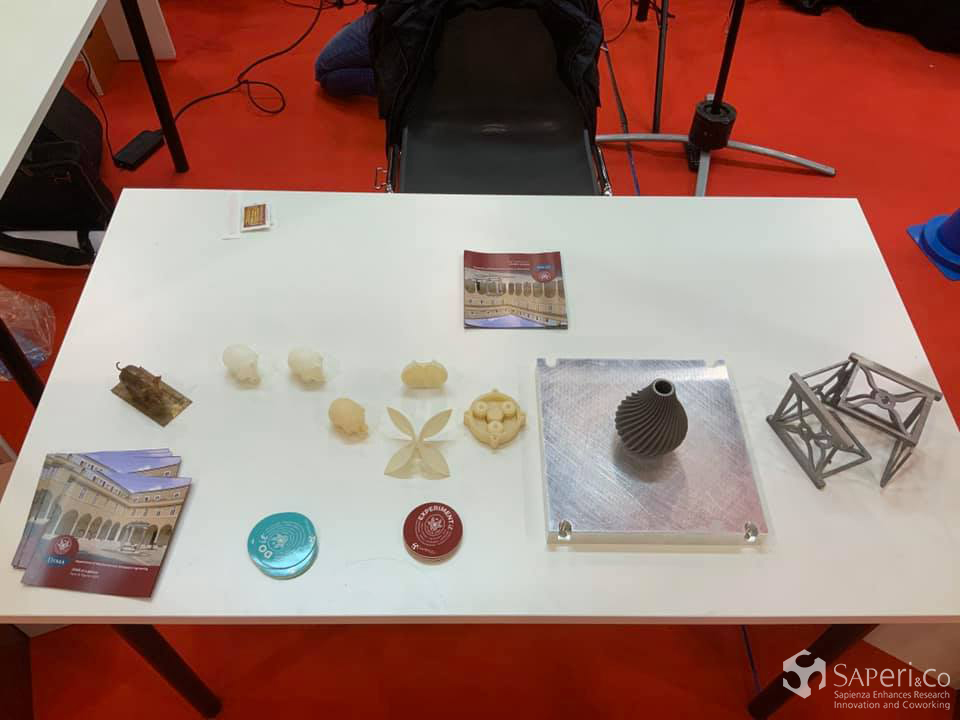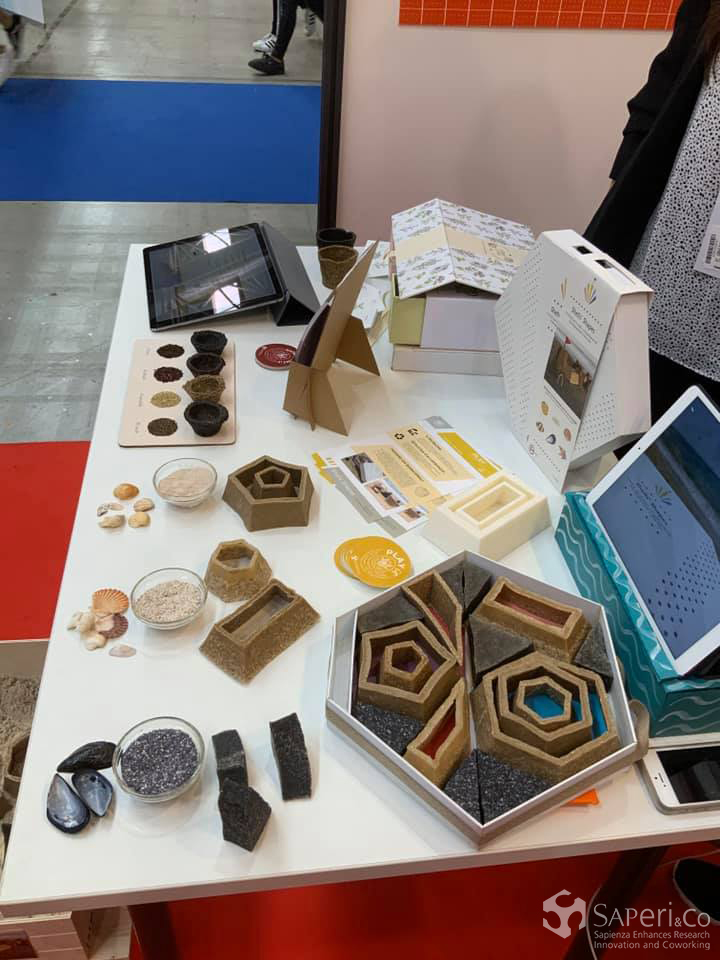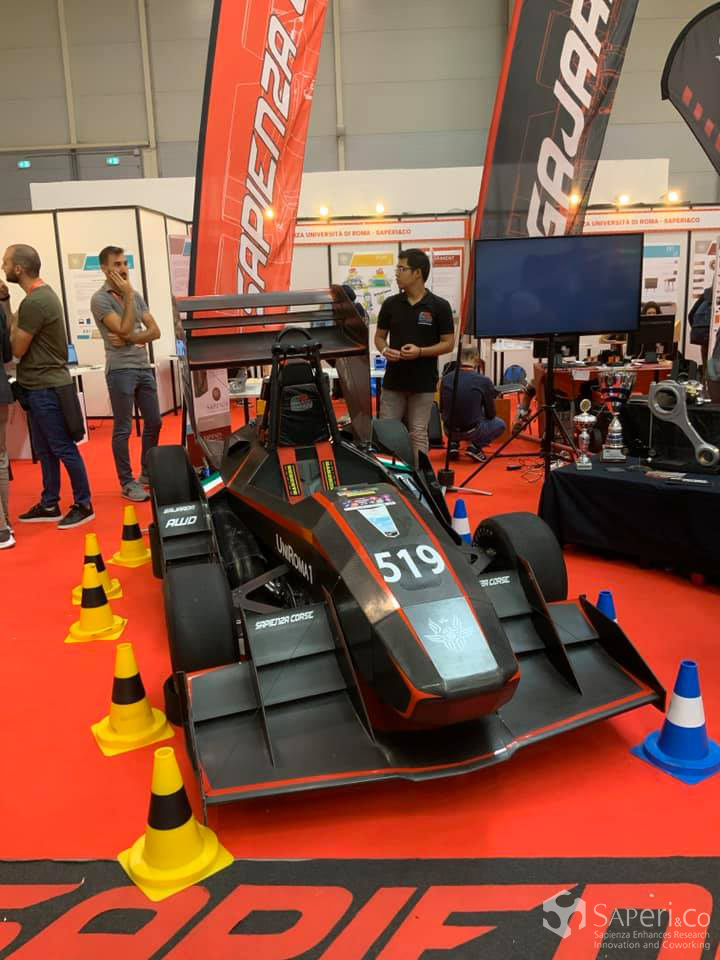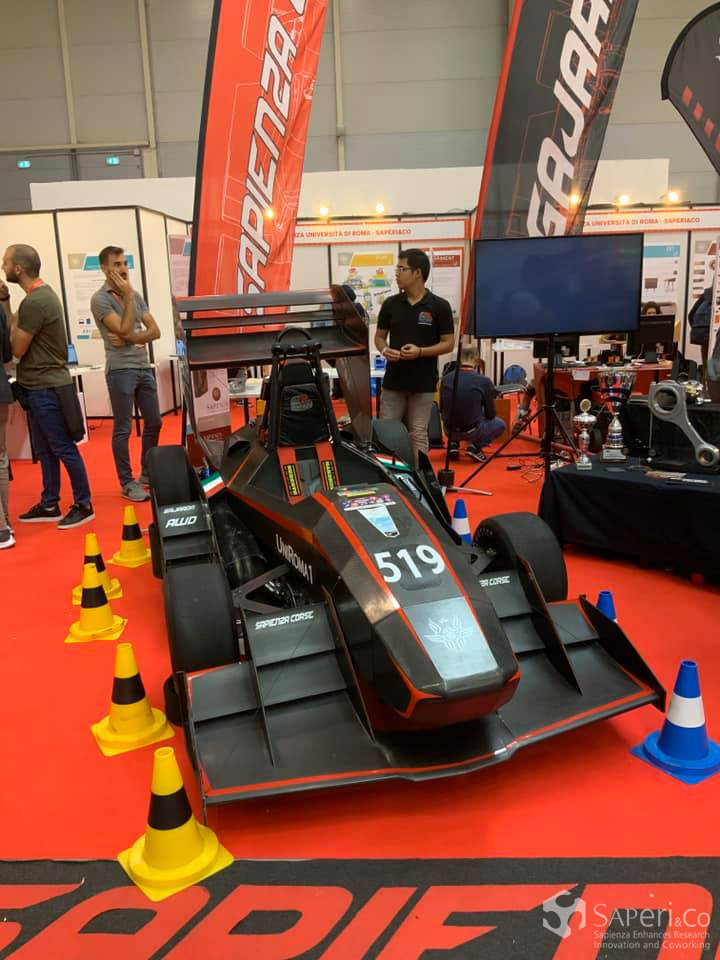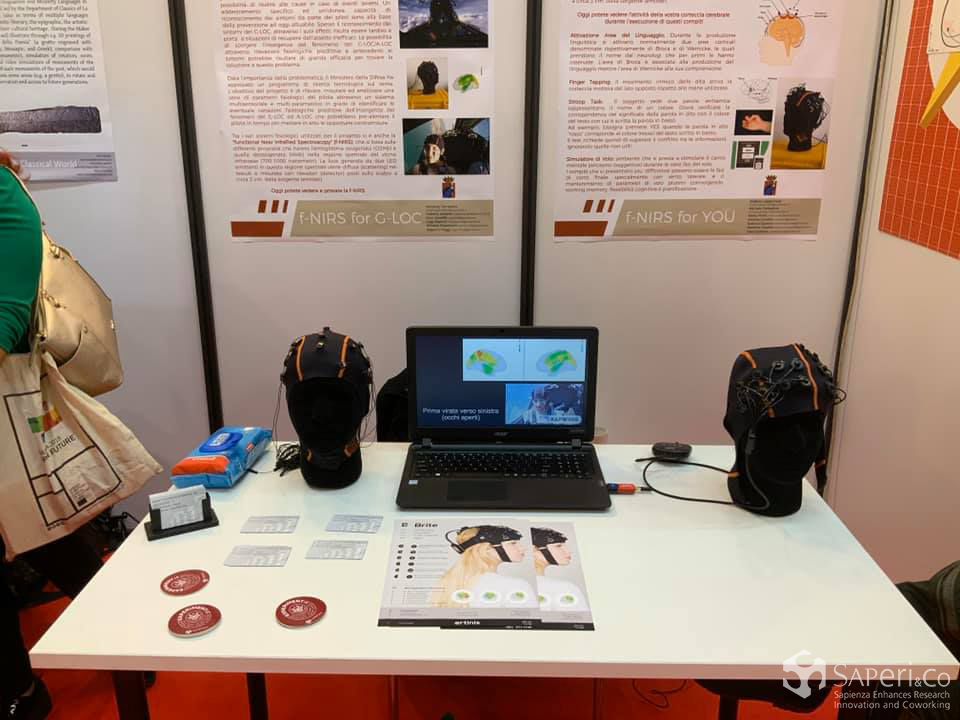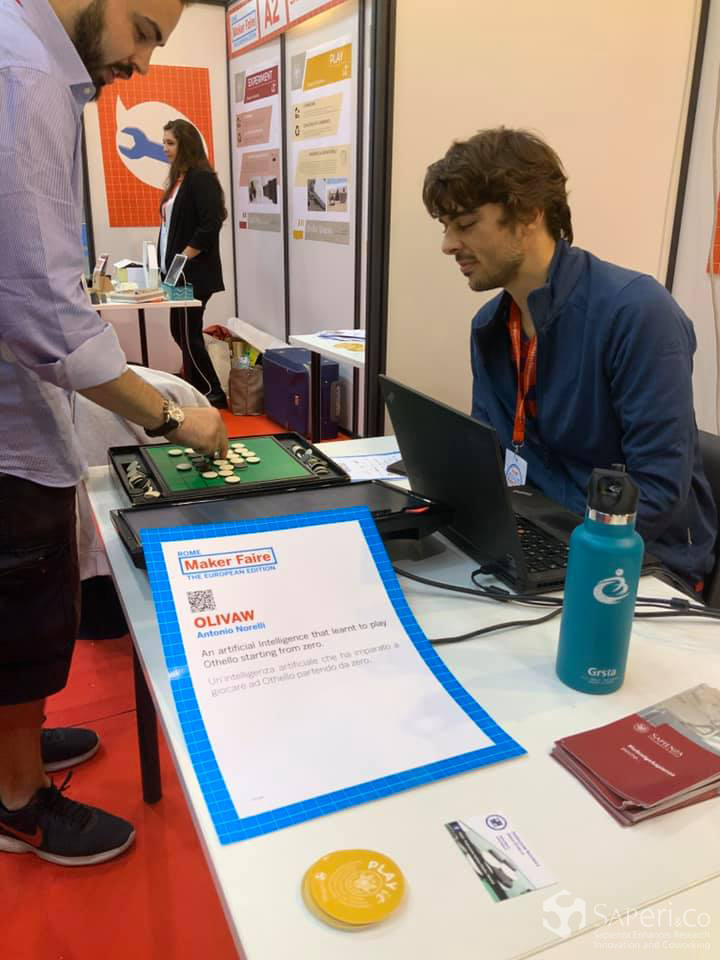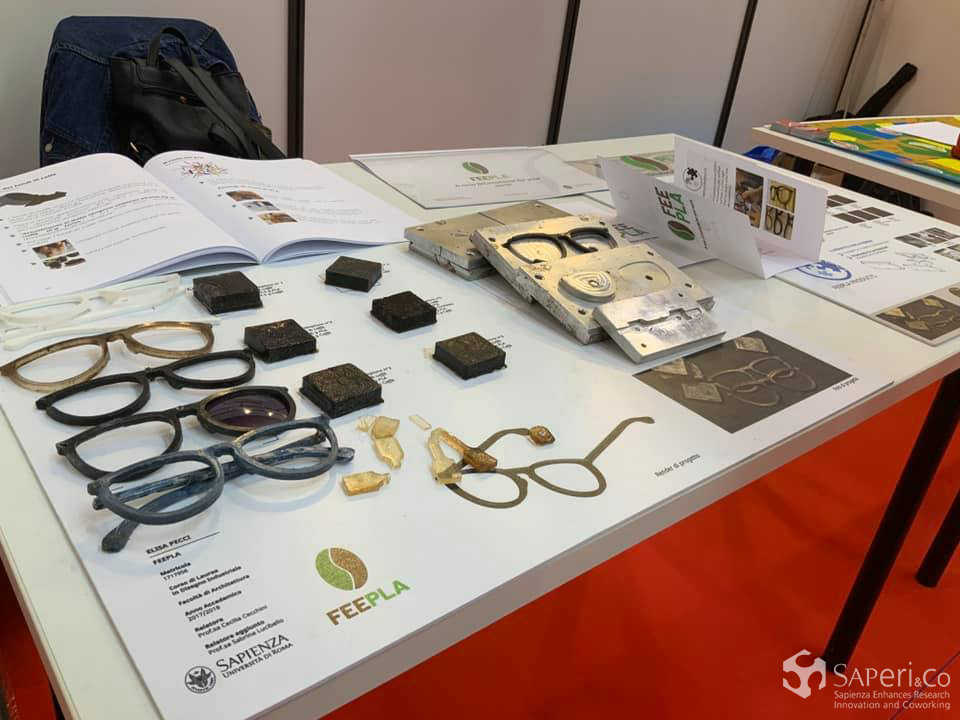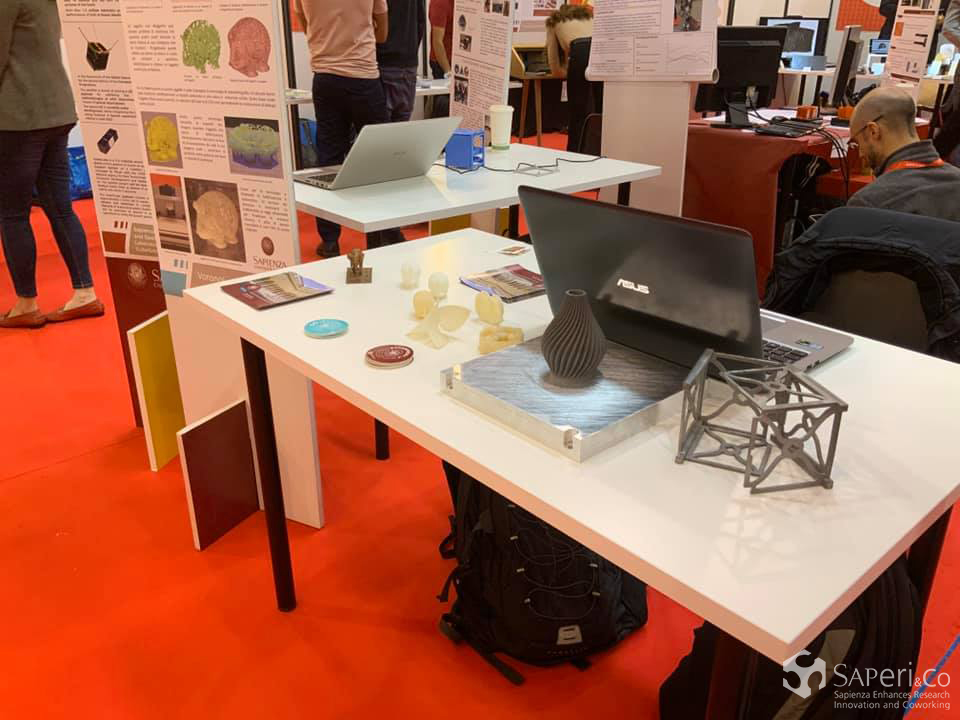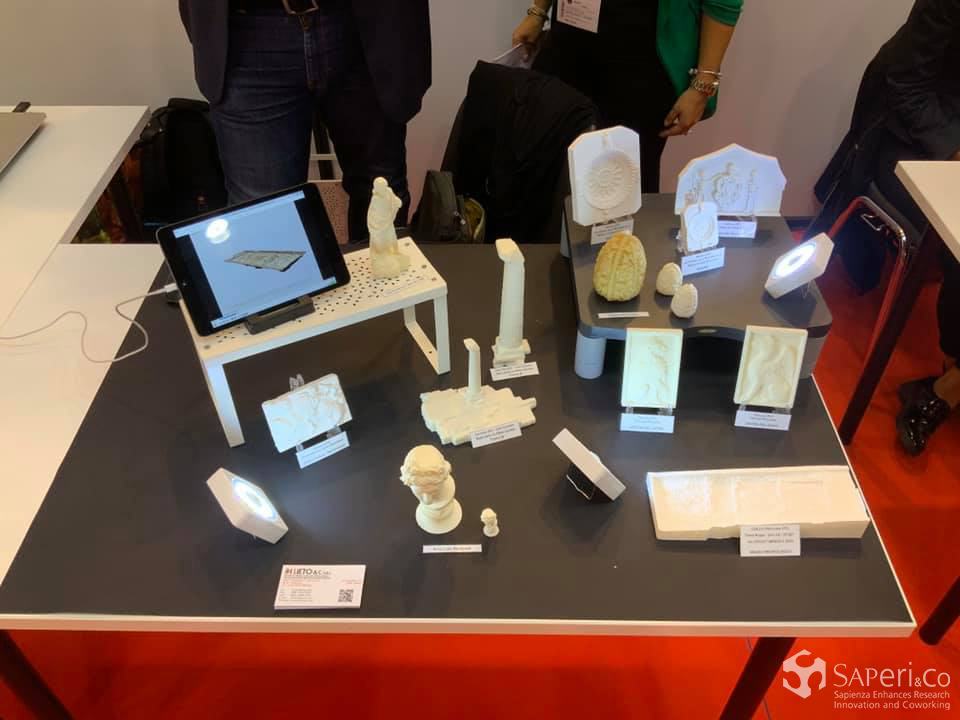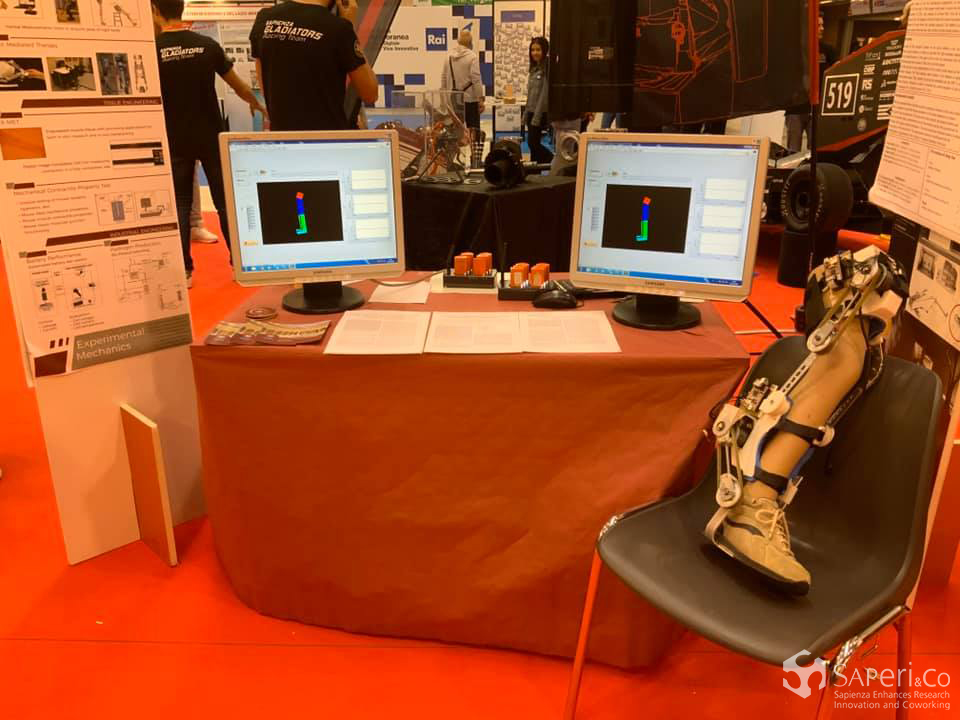
SAPeri&Co x Sapienza: Maker Faire Rome 2019
With the participation of 14 Departments, the Sapienza University of Rome stand this year at Maker Faire Rome 2019 held at the Fiera di Roma from 18 to 20 October 2019 hosted more than 30 projects from multiple disciplinary areas. Curated by the PhD students in Design Lorena Trebbi and Chiara Del Gesso, with the help of the designers Eugenia Canepone, Carmen Rotondi and the SAPeri&Co technician Luciano Fattore, the stand was a great success, presenting projects that apply advanced technologies, of which several made right inside the Fab Lab SAPeri&Co.
Team and Projects
Play it
|
OLIVAW |
|
Antonio Norelli |
|
OLIVAW: an artificial intelligence that learned to play Othello from scratch. It is 1997 and for the first time in history, world chess champion Garry Kasparov loses against a machine, DeepBlue, developed by IBM with the help of great chess masters. In 2016 it's Lee Sedol's turn, one of the greatest Go players ever is defeated by DeepMind's AlphaGo (Google), a new generation program based on neural networks that learned how to play by analyzing the games of professional players. A year later something disconcerting happens, AlphaGo is beaten 100-0 by a new version, AlphaGo Zero, which however has learned to play independently, starting only from the rules and improving by playing against itself. Human knowledge in the game is no longer necessary, it becomes limiting. At the IT department of Sapienza we have reproduced this latest result on a simpler but always interesting game, Othello, using computational resources accessible to anyone: a laptop and free cloud computing platforms. The AI is called OLIVAW, and at Maker Faire 2019 you can challenge it for the first time. Up to what difficulty level can you beat him? You can also find out everything about how it works with the author. In a talk instead we will tell the genesis of OLIVAW, we will start from why today games are at the center of advances in artificial intelligence and we will end with the most exciting moments of the challenges between OLIVAW and Alessandro Di Mattei, Italian champion of Othello 2019, and Michele Borassi , 2008 world champion. |
|
GiochiAMO |
|
Barbara Dorelli |
|
GiochiAMO is a product of the homonymous project and is intended for primary school children, primary school teachers and parents of children in these age groups. The initiative is part of a broad line of studies in the field of health promotion in schools, universities, the workplace and in the community. The aim is to increase knowledge and good practices in children and their parents on the 4 key aspects of prevention: healthy nutrition, physical activity and the fight against smoking and alcohol. In addition to promoting good mental and social health, play creates a context in which discussion, socializing and active learning are facilitated. GiochiAMO, thanks to field trials that have made it possible to demonstrate efficacy, has resulted in significant changes in children's behavior and knowledge. The traditional transmission of knowledge was in fact supported by play, a tool for growth and interaction with a promising educational and pedagogical value. GiochiAMO has an aggregative and creative nature, and uses playful activities for its purposes such as card, board and movement games, but also life skills to consolidate the acquisition of a positive and flexible behavior in the face of the difficulties of everyday life. |
|
LEAF LIFE |
|
Lucia Mafodda |
|
Obtain vessels in biomaterial. The project was born from the reflection on the seriousness of environmental pollution and from the need to sensitize buyers on the subject, making them understand the potential value of organic waste. Inside the kit (made with recyclable materials), the following are provided: an instruction booklet, tea bags, a mold, seed bags, plant markers. According to the instructions provided in the booklet, after tasting the infusions, a recipe is followed that allows you to obtain a compound to be poured into the mold, in order to recycle the waste by obtaining biodegradable jars. The seeds of aromatic herbs are then planted which, once grown, can be used to enrich new herbal teas. The pot can also be buried becoming nourishment for the plant: this demonstrates the circularity of the biomaterials. The kit contains: an instruction booklet, 20 tea bags (5 for each type: black tea, green tea, karkadè, chamomile), a mold, 20 seed bags (5 for each type: passionflower, valerian, dill, thyme ), 10 marks plants. Various types of paper and cardboard were used to make the box, the sachets, the plant markers and the instruction booklet; the mold was made in PLA through 3D printing. |
|
DO IT with MATERIALS |
|
Silvia di Anselmo |
|
“Materials do it yourself” is a kit dedicated to children, with the aim of developing their awareness of the work processes behind the objects of our daily life. |
|
GAJARDA |
|
Sapienza Corse: |
|
Sapienza Corse is a team of students participating in the Formula Student inter-university championship with "Gajarda" the single-seater they designed and built entirely. In 2019 Sapienza Corse faced a new challenge: involving Gajarda in the "driverless" category, in which the cars transformed for autonomous driving compete on the same tracks used by the piloted single-seaters. The aim is to compete against other universities in the world in events in which what matters is not only speed performance, but being able to demonstrate that you know how to make a project, realize it and convincingly present it. Being part of Sapienza Corse means living an intense training experience that allows you to put your creativity, enthusiasm and dedication to good use in preparing for the world of work. |
|
Quitash |
|
Patrizio Cipollone |
|
DIMA for Motorsport Gladiators |
|
Giulio di Rienzo |
|
DIMA for Energy |
|
Domenico Borello |
Experiment it
|
SHELLS SHAPES |
|
Francesca Vacca |
|
"Shells' Shapes" are molds for the sea made with biomaterial derived from shells. The peculiarity of these toys lies in their complete biodegradability at the end of their life. At the base of their creation lies the problem of environmental pollution due to synthetic plastics, which has given rise to a great parenthesis that involves each of us every day. This has led to the need to seek solutions to reduce the excessive production of waste that ends up in the seas and oceans. One model to follow is that of circular economies that reduce and eliminate waste. The proposed idea is to replace the toys for the sea, often left on the beaches, with a product that could be "easily" forgotten in the sand because it does not alter the ecosystem. The choice to act on the world of children derives from the assumption that they will be the ones to take care of our planet and this project is a chance to make them reflect and at the same time have fun. The watchwords are: "Collecting is better than Throwing!” |
|
NIRS |
|
Roberto Ripamonti |
|
Brain signals and psychophysical stress during the flight. Collaboration between Brainy Solutions Enterprise S.r.l. - Ministry of Defense - Department of Psychology "Sapienza" The dynamic stresses induced by flights on high-performance airplanes can induce loss and / or alterations of consciousness (G-LOC: Gravity-induced Loss Of Consciousness; A-LOC: Almost Loss Of Consciousness) with often fatal consequences. At present, the primary and / or concomitant causes of these phenomena have not yet been identified. Our research team is currently investigating the psychophysiological-cerebral correlates of G-LOC through EEG, and NIRS (Near-Infrared-Spectroscopy) During the event, the public will be able to try to wear the NIRS sensors and view their own sensors in real time. brain responses when performing simple cognitive stress conflict tests and during flight simulation. |
|
Li-Fi |
|
Andrea Petroni |
|
The project is part of ICT (Information and Communication Technology), and specifically concerns the creation of optical communications, where properly piloted light signals are used to transmit data. In this context, the experience to be presented is a demonstration of optical data transmission (for example image or text) which involves the use of LEDs in transmission and photodiodes in reception, suitably controlled by PC and Arduino boards (Figure 2 -3). Specifically, it will be shown how it is possible to encode the information to be transmitted into a light signal and, subsequently, how in reception the transmitted data can be reconstructed starting from the light signal captured by the photodiode. The public will have the opportunity to interact, going directly to pilot the transmission system through the PC |
|
KINEBOARD |
|
Marco Ferrantini |
|
In the last year and a half, following a serious accident that I had, I have experienced on my skin the importance of physiotherapy and physical activity in the perspective of a complete and effective rehabilitation. In particular, among the various exercises that I had to perform, I found it very useful to work with the "" proprioceptive platform "". This platform is the classic wooden board on which you try to stay in balance; the goal is to be able to regain granular and efficient muscle control, which is essential for returning to walking correctly. Progress can be assessed in various ways, but it is more difficult to understand what aspects to improve. So I thought of a device that can be installed on these simple boards that can transform the exercise into an interactive game with objectives calculated ad hoc on the patient / player. Kineboard is exactly that. The functionalities are many, as well as the areas of use: just think that postural anomalies can be predictive of the symptoms of autism spectrum disorders. Such a tool could make it possible to provide an effective therapy also for this purpose but with a playful aspect that is very useful especially for children. There are already computerized platforms that allow the reading of data, but they are expensive solutions (thousands of euros) that very often are not within the reach of small studios and clinics, as in the case of my rehabilitation. In this regard, the Kineboard module is a very low cost solution based on Arduino and enclosed in a 3D printed body, which offers: real-time data reading through accelerometers / gyroscopes, creation of maps, graphs and patient reports, video games " "therapeutic" "with which to interact through movement on the platform with ad hoc calculated objectives, creation of rankings and histories to map patient progress, wireless bluetooth connection, web platform that does not require installation |
|
Skobyskin |
|
Lorena Trebbi |
|
FEEPLA |
|
Elisa Pecci |
|
The FEEPLA project consists in the realization of a bioplastic born from the mixture of PLA waste and coffee grounds. The project aims to provide a sustainable alternative to the use of fossil-based plastics, with the recovery of waste with excellent characteristics: PLA - fermented corn starch (matrix) coffee grounds - excellent properties in the role of fiber of the blend. FEEPLA is therefore a biodegradable and compostable plastic. With FEEPLA, the first frame for eyeglasses / sunglasses is born. The choice of this object is intended to be the demonstration that a plastic free world is possible, starting with everyday objects. |
|
DIMA for biomedical engineering |
|
Livio D'Alvia |
|
EmStation |
|
Francesco Colasanti |
Do it
|
MEMENTO |
|
Eugenia Canepone |
|
Memento is a design-oriented desk with simple and elegant lines that represent a timeless icon. The idea behind this product is to stimulate the appeal of the product by focusing on the emotional value of the object, enhancing its sensory and material expressiveness through the five senses and highlighting their physical interaction with the surrounding environment. without the help of advanced technologies but focusing entirely on the human experience. |
|
New Technologies & The Classical World |
|
Sara Kaczko |
|
The project aims to show how cutting-edge technological solutions, combined with the traditional disciplines of the sector, are essential for an in-depth knowledge of the archaic world, in particular Greek and Latin. The Department of Ancient Sciences is active in a series of projects of international importance (eg "Multilingualism and Minority Languages in Ancient Europe"; MuMiL-EU Hera JRP Project "Uses of the Past" - Horizon 2020; "Progetto Roca" in Agreement with SABAP-LE, Unisalento) which analyze multiculturalism, multilingualism (also understood as a multiplicity of languages: linguistic-literary, epigraphic, artistic-archaeological), linguistic contact in ancient Italy (VI BC-III AD) and their cultural heritage. To this end, 3D photogrammetric surveys and scans with high-definition laser scanners of Greek and Latin inscriptions and epicoric languages of Italy on various supports (stone, ceramic and walls of the "Grotta della Poesia") were carried out with the latest generation equipment. which allow the study of such testimonies of the past which would otherwise be difficult or impossible, eg. for difficulty in accessing the sites (cave) and for rotating fragile or heavy supports. Examples will be offered to the public such as: 3D printing of a cast of the inscriptions of the "Grotta della Poesia"; video reconstruction of the same; interactive simulation of rotation, zoom, variation of light angle of inscribed artefacts; demonstration and practical exercise of the elaboration of casts of inscriptions. |
|
STONY SILENCE |
|
Gaia Bilotta |
|
The proposal concerns a panel for cladding of facades in noisy areas, indoors and outdoors, which exploits the natural properties of stone combined with a simple geometric shape and a cavity pattern, thus creating a fractured surface capable of sound absorption and refraction. sound. The goal is to create a barrier that, if placed outdoors, can reduce and disperse the noise that is usually reflected and, in this way, increased by the buildings overlooking the city streets and squares. When used indoors, it can equally have a positive effect on the environment in particular noisy conditions such as restaurants or shopping malls or where sound needs to be controlled in a specific way, such as in auditoriums, concert halls and even laboratories. For Maker Faire it will be available in full-scale stone prototype and some reduced models made with 3D printing. A system (under study) is envisaged that allows the public to experience the difference between the reflection of a smooth, uncoated wall and a wall covered by the panel. Given the difficulty of performing acoustic tests in a noisy place such as the Fair, we intend to visualize the reflection effect by means of colored fluids or light filaments stirred by a jet of air. |
|
TALKING STONE |
|
Damiano Amicucci |
|
The project concerns a “communicative” wall element suitable for different functions; in the attached project it is, in particular, the facade of a library / bookstore. The idea stems from the desire to combine the ancient and symbolic value of stone, seen as a powerful means of expression since prehistoric times, with modern technologies. The latest trend in this industry is the QR code, a type of barcode that contains a matrix of dots and can store up to one hundred times more information than a conventional horizontal barcode. It can be simply scanned using a smartphone or other everyday device, such as tablets, which connect directly to texts, emails, websites and many more, making this information accessible to all. Therefore, in order to create an interactive communication, a marble element with a QR code is proposed, which transforms the immobility of the stone into a dynamic becoming. Indeed, the panels can be customized to contain various elements of information (such as opening hours, special events and activities, catalogs, contacts). At Maker Faire a panel will be presented which, when viewed from the visitors' smartphone, will open an interactive site with communications relating to research activities and any interactive applications. The prototype will be completed by explanatory panels and presentation videos. |
|
STONE PRINTING |
|
Berloco Marco |
|
The project stems from an environmental initiative: the large amount of natural stone products used in the construction sector generates significant quantities of sludge deposits, estimated at five million tons per year in Europe. The legislative decree n. 205/2010 of directive 98/2008 sets the goal of achieving 70% recycling from C&D by 2020 (Italy is stuck at 10% today!). Thanks to 3D printing, sludge waste returns to the solid state with superior characteristics and this "mixture" can cost up to 1/3 of the starting material. The final characteristics of these products compared to conventional products as well as being "eco" have all the advantages of 3D printing: Greater innovation: ✓ possibility to print prototypes in a few hours, get feedback, refine projects and repeat the cycle until obtaining a perfect result Better communication: ✓ A realistic 3d model and color can convey much more information than an image to the computer Shorter time to market: ✓ 3D printing of multiple prototypes on demand simplifies design cycles Fewer development costs: ✓ lower costs for traditional prototyping and manufacturing processes ✓ early identification of design errors ✓ reduce trips to production facilities Customer acquisition: ✓ ability to show potential customers, sponsors and interest groups of 3d models realistic For Maker Faire, not being able to make a 3D printing on site, we intend to supply to the public the possibility of assembling the various basic panels (3D printed on a reduced scale or directly on the computer) to form parts of a building or urban furniture, while providing data on the cost of construction and savings in terms of reuse of waste |
|
3D-RES |
|
Prof. Paolo DeFilippis (Project Director) |
|
An innovative Research Project, called '3D-RES' (acronym of 3DIMENSIONAL REAL RESERVOIR, was launched as part of the 'Oil and Natural Gas Technologies' course of the Department of Chemical, Materials and Environmental Engineering of the Sapienza University of Rome. - REAL 3D DIMENSIONAL FIELDS): the project has as its objectives the Dissemination and Public Awareness of Technology in the Oil & Gas and Hydrocarbon Production Industry The innovation introduced by our research team with the “3D-RES” project is the 3D prototype of the hydrocarbon field which, starting from the virtual 3D geological model, is physically created by a special 3D printer; it is a real and faithful reproduction of the original model on a reduced scale, and it is a real 3D representation of the reservoir in which all the geological layers, the drilled wells, the faults, the superficial and deep aquifers, the structural alternations, etc. etc; this is for both on-shore (onshore) and off-shore (offshore) fields. The goal is to propose the 3D prototype as a new 3D "see & touch" dissemination and dissemination tool that could represent a front-end, restoring trust and security through an adequate response to the common doubts of all Stakeholders, State and Local Administrators, Non-Governmental Organizations, Local Spontaneous Committees, Environmental Organizations and ordinary private citizens. |
|
Digital Technolgy for cultural Heditage |
|
Sapienza Design Factory |
|
Processes for the 3D reconstruction of the bust of Silvio Pellico, Italian writer, poet and patriot of the XVIII century. Research and realization by the Sapienza Design Factory Laboratory of the PDTA Department (Planning, Design, Architecture Technology) for the Department DIAG (Antonio Ruberti automatic and management computer engineering) The project involved the recovery of the lost bust of Silvio Pellico for the headquarters of the DIAG Department. reconstruction and digitization of data; optimization for additive manufacturing; 3D printing of the bust in FDM. (22x30x50cm) |
|
DIMA for advanced manufacturing |
|
Flavio Carrara |
|
DIMA satelliti |
|
Acernese Marco |
|
School of Physics with Arduino |
|
Giovanni Organtini |
Photo gallery






